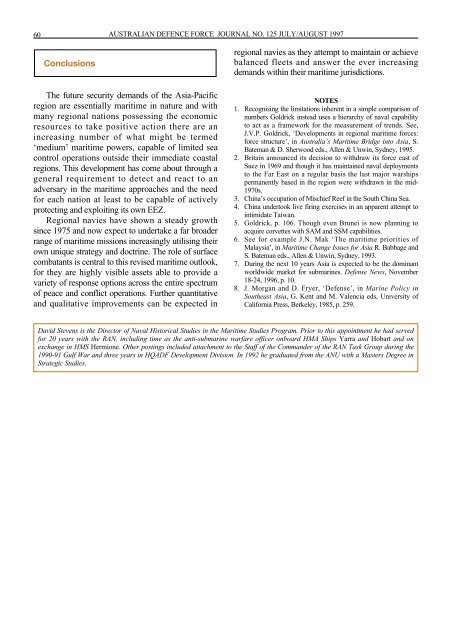ISSUE 125 : Jul/Aug - 1997 - Australian Defence Force Journal
ISSUE 125 : Jul/Aug - 1997 - Australian Defence Force Journal
ISSUE 125 : Jul/Aug - 1997 - Australian Defence Force Journal
You also want an ePaper? Increase the reach of your titles
YUMPU automatically turns print PDFs into web optimized ePapers that Google loves.
60AUSTRALIAN DEFENCE FORCE JOURNAL NO. <strong>125</strong> JULY/AUGUST <strong>1997</strong>ConclusionsThe future security demands of the Asia-Pacificregion are essentially maritime in nature and withmany regional nations possessing the economicresources to take positive action there are anincreasing number of what might be termed‘medium’ maritime powers, capable of limited seacontrol operations outside their immediate coastalregions. This development has come about through ageneral requirement to detect and react to anadversary in the maritime approaches and the needfor each nation at least to be capable of activelyprotecting and exploiting its own EEZ.Regional navies have shown a steady growthsince 1975 and now expect to undertake a far broaderrange of maritime missions increasingly utilising theirown unique strategy and doctrine. The role of surfacecombatants is central to this revised maritime outlook,for they are highly visible assets able to provide avariety of response options across the entire spectrumof peace and conflict operations. Further quantitativeand qualitative improvements can be expected inregional navies as they attempt to maintain or achievebalanced fleets and answer the ever increasingdemands within their maritime jurisdictions.NOTES1. Recognising the limitations inherent in a simple comparison ofnumbers Goldrick instead uses a hierarchy of naval capabilityto act as a framework for the measurement of trends. See,J.V.P. Goldrick, ‘Developments in regional maritime forces:force structure’, in Australia’s Maritime Bridge into Asia, S.Bateman & D. Sherwood eds., Allen & Unwin, Sydney, 1995.2. Britain announced its decision to withdraw its force east ofSuez in 1969 and though it has maintained naval deploymentsto the Far East on a regular basis the last major warshipspermanently based in the region were withdrawn in the mid-1970s.3. China’s occupation of Mischief Reef in the South China Sea.4. China undertook live firing exercises in an apparent attempt tointimidate Taiwan.5. Goldrick, p. 106. Though even Brunei is now planning toacquire corvettes with SAM and SSM capabilities.6. See for example J.N. Mak ‘The maritime priorities ofMalaysia’, in Maritime Change Issues for Asia R. Babbage andS. Bateman eds., Allen & Unwin, Sydney, 1993.7. During the next 10 years Asia is expected to be the dominantworldwide market for submarines. Defense News, November18-24, 1996, p. 10.8. J. Morgan and D. Fryer, ‘Defense’, in Marine Policy inSoutheast Asia, G. Kent and M. Valencia eds, University ofCalifornia Press, Berkeley, 1985, p. 259.David Stevens is the Director of Naval Historical Studies in the Maritime Studies Program. Prior to this appointment he had servedfor 20 years with the RAN, including time as the anti-submarine warfare officer onboard HMA Ships Yarra and Hobart and onexchange in HMS Hermione. Other postings included attachment to the Staff of the Commander of the RAN Task Group during the1990-91 Gulf War and three years in HQADF Development Division. In 1992 he graduated from the ANU with a Masters Degree inStrategic Studies.
















